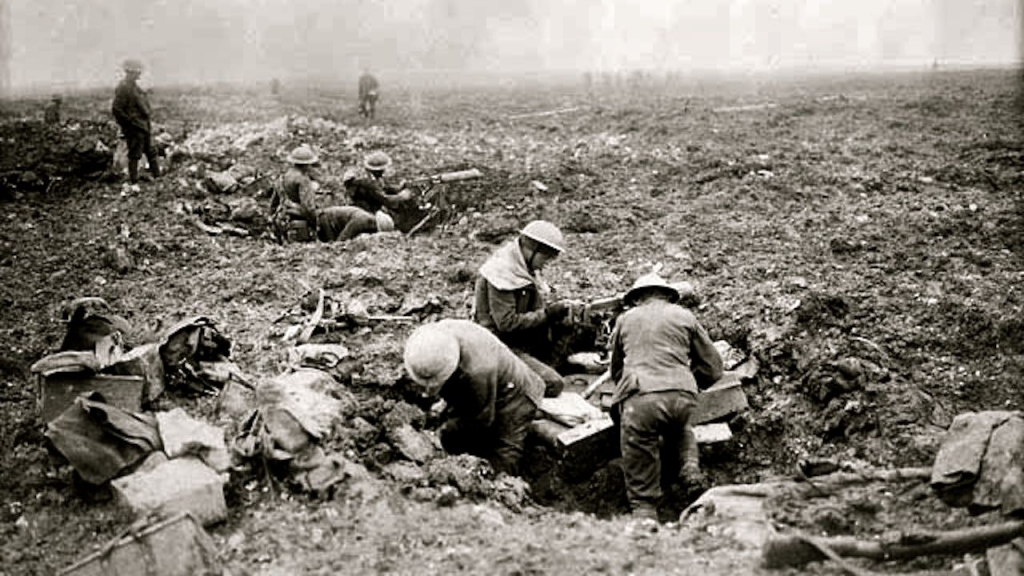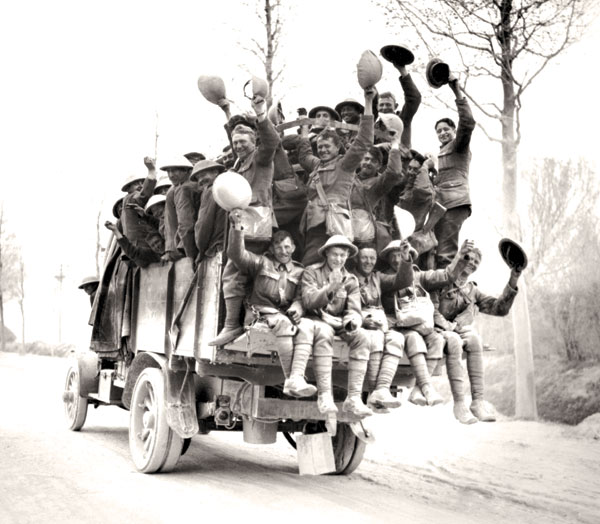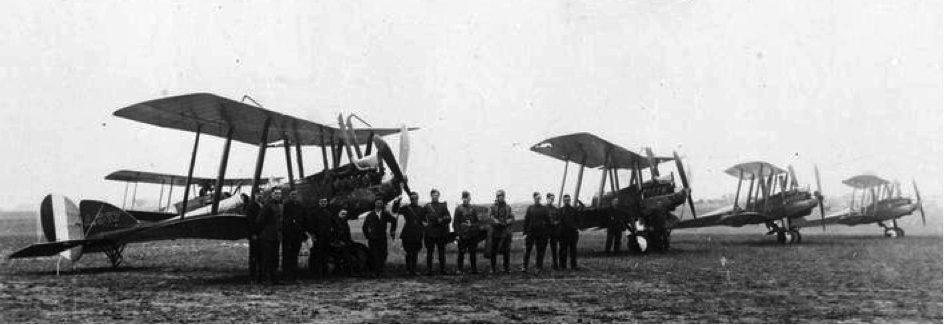Battle of Arras 1917

Canadian machine gunners in shell holes at Vimy advance, April, 1917. (libraries and archives Canada a1079).
Image from www.mapleleafup.ca
After the culmination of the Battle of the Somme, troops on the Western Front dug in for an icy cold winter. The sub-zero temperatures froze food, drink, blankets and clothes: many men suffered from frostbite and trench foot. Shelling continued throughout the arctic weather conditions.
Fonquevillers (known to the troops as Funky Villas) became the headquarters for the 46th Division in June 1916. After suffering appalling casualties on July 1st 1916, the division stayed in the sector during the harsh winter months and continued to experience losses.
January 24th 1917, Fonquevillers. Death of Private 4368 John Vellam Stafford, 8th Bn., Sherwood Foresters, 139th Brigade, 46th Division. He lived at The Green, Radcliffe on Trent and was killed, age 19, near Fonquevillers village, 18 km S.W. of Arras.
The Hindenberg line was built by the Germans during the winter and stretched from Arras to the Aisne. The Germans carried out a strategic withdrawal to the line from March 14th – April 5th 1917, destroying everything behind them, to form a more powerful defensive position.
The Canadian Field Artillery, 2nd Division, was fighting north-west of Arras in early March, in the vicinity of Bruay.
March 18th 1917, Le Treport. Death of Driver William Roberts, Ammunition Column, Canadian Field Artillery, 2nd Division. He had been a regular soldier in the past and his mother lived in Radcliffe. He emigrated to Canada in 1911 and died, age 41, in a military hospital at Le Treport, near Dieppe.
Battle of Arras, France
April 9th – May 16th 1917
The Battle of Arras was a combined British and Commonwealth offensive involving troops from Canada, South Africa, New Zealand, Newfoundland and Australia. The troops attacked German defences near the city of Arras. Major gains on the first day were followed by stalemate. First, Third and Fifth Armies were present. The outstanding success of the battle was the capture of Vimy Ridge by four divisions of the Canadian Expeditionary Force whose well planned strategy enabled them to take the high ground.

Canadians returning from action at Vimy Ridge. From Library and Archives Canada, image PA001270
April 28th 1917, Arras. 2nd Lieutenant Percy Cox, 25th Bn. (Tyneside Irish) Northumberland Fusiliers, 103rd Brigade, 34th Division, was killed near Arras, age 21. He was from Chestnut Grove, Radcliffe. The 25th Battalion were involved in the fierce Battle of Arleux from 28th–29th April which involved repeated counter-attacks by the Germans and great losses.
An unofficial report dated April 28th 1917 from Corporal W.A.P. Rogers describes how Percy Cox met his death:
He was my M/G officer. You never met a finer man. He was of medium height but well built. On April 28th during the fighting I had one L/G team in a shell hole and on my left we had another gun. The Lieut. had given some instructions to the team on my left and as I saw him running towards me I stopped firing. About half way between he was hit in the neck and killed on the spot. There were snipers, fixed rifles and M/G everywhere . It could not have been hotter, As the attack was not a success, Mr. Cox would be left. This was on the left of the chemical works, Arras. Corporal Rogers 47048, Northumberland Fusiliers, 25.C., L. Gun school, 3.8.1917, Etaples (source Percy Cox’s service records held at the National Archives).
How Radcliffe servicemen died
Radcliffe Servicemen and British Army
1914 Retreat from Mons
1914 Battle of the Marne, 1st Battle of Ypres
1915 Battle of Neuve Chapelle, Aubers Ridge
1915 Gallipoli
1915 2nd Battle of Ypres and other conflicts
1916 Conflicts prior to the Somme
1916 Battle of the Somme July
1916 Battle of the Somme August
1916 Battle of the Somme Autumn
1917 Battle of Arras
1917 3rd Battle of Ypres
1917 3rd Battle of Ypres (Passchendaele)
1918 German Spring Offensive
1918 3rd Battle of the Aisne
1918 HMS Leasowe Castle torpedoed
1918 Last 100 Days, 5th Battle of Ypres
1918 Final Days
1918 The Armistice
Other Conflicts
June 28th 1917, Messines, Belgium. Death of Private 41108 Gale Nowell, 17th Bn., Sherwood Foresters, 117th Brigade, 39th Division. He was a printer’s assistant in Radcliffe and brother of George, who died at the Somme. He was killed, age 20, at the end of June shortly after the Battle of Messines. ‘Battalion working at full strength in Front Line and vicinity during all hours of darkness’ on the date he died.
Fighting in the Arras area continued in the summer of 1917. The 46th Division had moved from Fonquevillers by June and was fighting north of Arras in the Liévin area when the following deaths occurred:
June 30th 1917, Liévin, France. Death of 2nd Lieutenant 2771 Sydney Newbury, 1st/7th Bn. Sherwood Foresters, 139th Brigade, 46th Division. He was a clerk with a London insurance broker and brother of Alvin, who was killed in 1916. He was badly wounded in the chest at Liévin (left sector) on June 30th and is recorded as dying of wounds the same day at No 7 Casualty Clearing Station.
July 2nd 1917, Liévin. Death of Private 267657 Samuel Eaton, 1st/7th Bn. Sherwood Foresters, 139th Brigade, 46th Division, a married farmer in West Bridgford, Notts. He died of wounds, age 34, between Bethune and Lens two days after Sydney Newbury, above.
July 3rd 1917, Feuchy, France. Death of Bombardier 69378 Thomas Peck, Royal Garrison Artillery, who was a school teacher in Radcliffe. He was killed, age 28, near the village of Feuchy, 5 km. east of Arras.
Role of the Royal Flying Corps
The Royal Flying Corps was part of the British Army in WWI. Initially, the RFC supported the army with reconnaissance work. As the war unfolded, the work expanded to include strafing enemy infantry, bombing German military airfields and, later, bombing industrial sites. The number of planes on both sides and the escalating demand for air warfare increased the need to train pilots quickly. The RAF evolved from the RFC and came into existence on April 1 1918 as an independent force on a par with the army and navy.
June 2nd 1917, Varennes. Lieutenant William Ritter, Royal Flying Corps, from Chestnut Grove, Radcliffe on Trent and neighbour of Percy Cox, was killed in a flying accident N. of Amiens, S. of Arras, Varennes area. He was an observer, age 23.

RFC two seater planes. Image courtesy of the Imperial War Museum Q53685
